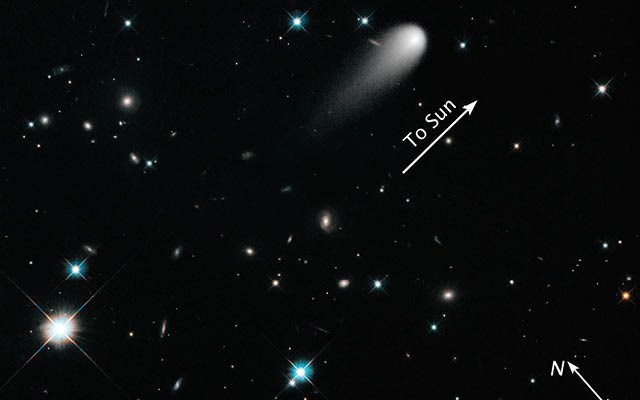Anything with a tail 16 million kilometres long is going to attract some attention. Space watchers like part-time Whistler resident John Nemy are keeping a close eye on Comet ISON and the massive amount of dust and gas falling away from the comet as it burns its way toward the sun.
The comet is known as a sungrazing comet, meaning it will orbit very close to the sun. It's expected to come within 1.2 million kilometres of the sun on Thursday, Nov. 28.
For the inhabitants of this part of Earth it means the comet could be very bright and easy to see for those with a clear view of the horizon in the early morning hours.
Nobody really knows what will happen to the comet as it rounds the sun but astronomers are very interested to see if it survives the close encounter. Space researchers are anxiously waiting to see if the sun's energy breaks up the comet. If the comet survives, the event is expected to teach scientists a great deal about the earliest days of the solar system.
Nemy plans to help interested Whistler residents learn more about Comet ISON by presenting The Wonder of a Comet at the Whistler Public Library tonight (Nov. 21) at 7 p.m.
The one-hour presentation will include his top 10 photos taken of the night sky around Whistler, his original music compositions and comet details.
"Whether the comet performs or not is not the issue," Nemy said a day after his return to Whistler from Hornby Island where he operates the Island Stars Observatory.
He got a picture of the comet on Saturday, Nov. 16 from his home on Hornby Island.
"It has brightened in the last three days," Nemy said on Monday, Nov. 18.
Russian astronomers Vitali Nevski and Artyom Novichonok first discovered Comet ISON in September of 2012.
NASA's Hubble Space Telescope focused on the comet back in April and May. Data collected from the telescope suggests the comet's nucleus is about five to eight kilometres across. NASA estimated in March the comet was losing about 51,000 kilograms (112,000 lbs) of dust and 60 kilograms (130 lbs) of water every minute.
Nemy described the massive satellite as a dirty snowball cruising through space at a temperature of 2,700 Celsius — hot enough to melt iron.
With the comet losing mass as it streaks toward the sun some astronomers have predicted it won't put on much of a show on the morning of Nov. 28.
"The comet still has the potential of becoming spectacular and if you don't look, you won't see it," said Nemy.
He's formulating a plan to get himself into a high-elevation spot where he can see the comet on Nov. 28.
Photographer David McColm is also planning to position himself to see the event. One of McColm's specialties is photographing the night sky.
"If there's a chance to shoot it, totally, totally, I'm going to try and get it," said McColm.
Nemy said the interest in Comet ISON reminds him of a comet that made headlines more than a decade ago.
"A similar comet came close to Jupiter in 1994 and it pulled apart," said Nemy.
The collision of Comet Shoemaker–Levy 9 provided new information about Jupiter. The crash also taught astronomers about how space debris is reduced in the inner solar system. The comet was pulled apart by Jupiter's gravitational pull.
"Comets are really beautiful," said Nemy.
While they look great at a distance he noted they can be highly destructive when they collide with planets. ISON isn't on a collision course with Earth but Nemy said if it was and it did slam into our planet it would have huge local impacts for the region around the landing point.
"If this comet hit us it would have changed a lot of things on the planet," said Nemy.
He said some scientists believe water was introduced to Earth through a comet collision.
Nemy stressed that ISON doesn't pose any danger to Earth but he noted the comet might impact our planet in a minor way.
"In January we cross paths with two parts of the tail," Nemy said.
If this does in fact happen it could bring meteor showers to our night skies.
"All these cosmic things underline our unique existence on this planet and that underscores the need to be kind to each other," said Nemy.
Always conscious of safety, Nemy said anyone who plans to attempt to view the comet should take steps to avoid looking directly at the sun.
The admission price to take in Nemy's presentation at the Whistler library is $10 and $20 for a family of four.
Nemy pointed out the Whistler Astronomy Club is expected to start meeting this winter with monthly meetings at the library planned for January, February, March and April. The meetings at the library will be augmented by star-gazing nights at Rainbow Park. More club information will be posted to the Facebook page dedicated to the astronomy club.




